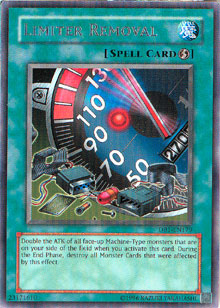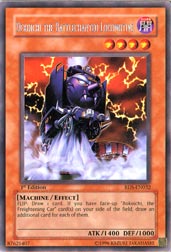
In general, I’m not a big fan of Chaos Return decks. To me, they’re the last remnants of the time when your options were to try to blow everything up with Chaos Emperor Dragon - Envoy of the End or win before the opponent got to do anything with the Magical Scientist/Catapult Turtle combo. Sometimes, though, a player will introduce something to the standard archetype that even I think is pretty cool. Most recently, I was impressed that Ryan Hayakawa chose to use Limiter Removal in his Top 8 deck from Shonen Jump Denver. Players frequently ignore type-based decks (other than Warriors), since it’s very difficult for other monster types to offer anything that competes with Reinforcement of the Army in terms of type-based support. Machines, however, don’t really have this problem. Even though it’s been limited once again, Limiter Removal remains one of the best type-specific support cards the game has ever seen.
 Against a clear field or with the aid of Jinzo, the text of Limiter Removal basically reads, “Win the game.” There aren’t any payments or discards, just victory, and it works with many of the monsters that duelists are already playing. The thing is, why stop at just a Limiter Removal thrown into a Chaos deck that happens to pack six or seven Machines? There isn’t any need to restrict yourself to just Light and Dark monsters when you’ve got four years of excellent Machine monsters to draw upon.
Against a clear field or with the aid of Jinzo, the text of Limiter Removal basically reads, “Win the game.” There aren’t any payments or discards, just victory, and it works with many of the monsters that duelists are already playing. The thing is, why stop at just a Limiter Removal thrown into a Chaos deck that happens to pack six or seven Machines? There isn’t any need to restrict yourself to just Light and Dark monsters when you’ve got four years of excellent Machine monsters to draw upon.
“Chicks Dig Giant Robots”
Monsters: 19
1 Jinzo
2 Ancient Gear Beast
3 Cyber Dragon
2 Reflect Bounder
1 Cannon Soldier
1 Cyber-Stein
3 Dekoichi the Battlechanted Locomotive
2 Magician of Faith
1 Sangan
1 Exiled Force
1 Breaker the Magical Warrior
1 Mystic Tomato
Spells: 13
1 Graceful Charity
1 Snatch Steal
1 Last Will
1 Heavy Storm
1 Mystical Space Typhoon
2 Nobleman of Crossout
2 Brain Control
1 Limiter Removal
2 Enemy Controller
1 Book of Moon
Traps: 8
2 Dust Tornado
1 Call of the Haunted
1 Mirror Force
1 Sakuretsu Armor
1 Magic Cylinder
2 Forced Back
Fusion: 3
1 Cyber Twin Dragon
1 Cyber End Dragon
1 Gatling Dragon
The basic goal for this deck (or any Machine deck, for that matter) is to dish out an obscene amount of damage as quickly as possible with little or no regard for one’s personal health or well-being. It only takes four or five direct attacks from your Machine monsters to win the game, fewer if you get Limiter Removal. Even better, your opponent is usually more than willing to help you out by summoning Cyber Dragon cards that you have plenty of opportunities to take control of and turn against their master. I mentioned above that the Machine deck plays with little or no regard to personal health or well-being. That means you can’t just sit there and hoard cards the entire game. You need to be constantly aggressive, or else the deck can’t work as intended.
The first thing that will take some getting used to is the idea that going second isn’t always horrible. You’ve seen it with Cyber-Stein decks that like to go second so that they can attack on their first turn, and the same reasoning applies here. In fact, Cyber-Stein is included in this deck, so that’s one of the things you should be looking for when considering your options. If you go second, either by choice or by your opponent’s choice, you want to immediately check for any first-turn win possibilities. It’s difficult to do, but if your opponent plays extremely conservatively (which is actually very likely) you might be able to pull it off. If he or she has set one card to each zone, you probably won’t get the win right there, but if he or she only has a monster, it’s entirely possible. Cyber Dragon, Exiled Force, and Last Will are all wins against a monster-only opening, and there are plenty more that you can find just by analyzing the decklist and some common opening situations.
 If you’re going first, you’ll probably want to set Dekoichi the Battlechanted Locomotive or summon Sangan, Mystic Tomato, or Reflect Bounder. I find the latter play to be more useful for this deck, since a face-up monster on the field implies that you’re aiming to play aggressively, and your opponent will often follow suit. This is excellent for you, since this kind of Machine deck benefits from short games with few face-down cards to deal with. You’ll want to back your summon up with Mystical Space Typhoon or a Dust Tornado so that you’re ready to lay on the beats next turn without much in the way of opposition. Remember, the most common opening play in the game is a set to each zone, so if you’ve got a Dust Tornado down on the first turn, you can eliminate the opponent’s backfield card before he or she gets a chance to use it. This then sets you up to look for one-turn win possibilities on your next turn if you so desire, and you really should. Toying with opponents is not smart and will likely land you in deep, dark, serious trouble, especially if you overextend to put his or her life points at a low, non-zero number.
If you’re going first, you’ll probably want to set Dekoichi the Battlechanted Locomotive or summon Sangan, Mystic Tomato, or Reflect Bounder. I find the latter play to be more useful for this deck, since a face-up monster on the field implies that you’re aiming to play aggressively, and your opponent will often follow suit. This is excellent for you, since this kind of Machine deck benefits from short games with few face-down cards to deal with. You’ll want to back your summon up with Mystical Space Typhoon or a Dust Tornado so that you’re ready to lay on the beats next turn without much in the way of opposition. Remember, the most common opening play in the game is a set to each zone, so if you’ve got a Dust Tornado down on the first turn, you can eliminate the opponent’s backfield card before he or she gets a chance to use it. This then sets you up to look for one-turn win possibilities on your next turn if you so desire, and you really should. Toying with opponents is not smart and will likely land you in deep, dark, serious trouble, especially if you overextend to put his or her life points at a low, non-zero number.
One of my favorite elements in this deck is the two copies of Forced Back: perfect against opponents packing plenty of Monarchs. Forced Back is also an important tool for stopping many other game-breaking cards from achieving their effects. You’re looking to stop Monarchs, Spirit Reaper cards, and flip-effect monsters, and while the monster may be bounced back to the opponent’s hand where he or she can easily reuse it at a later point in the duel, you should be concerned with making sure that the later point in question never occurs. Forced Back really makes an excellent addition to any aggressive deck in either the main or side deck, but for some reason no one is even side decking it, let alone main decking it. Perhaps it’s out of fear of decks containing three copies of Cyber Dragon and Chaos Sorcerer ,or maybe the current play style calls for dealing with threats after they’ve hit the board rather than preventing or holding them off. But I don’t think that either of these are a good excuse for overlooking Forced Back.
 A major concern for you, as the angry aggressive player, is dealing with the crazy conservative player. This is the guy who plays every card he gets face down and jumps on the train to Turtle Town every time you summon something. He or she is the reason that the deck packs two copies of Ancient Gear Beast—another card that gets no credit just because it has 100 less ATK than Cyber Dragon. Fine, the opponent can hit it with Cyber Dragon next turn (maybe), but before it goes to the graveyard, Ancient Gear Beast is going to take something down in a big Balter-esque way. Negating the effects of monsters it destroys is a brilliant effect, and built-in protection from Mirror Force is an added bonus. Ancient Gear Beast will take the conservative player apart piece by piece, starting with his or her Treeborn Frog, continuing with Dekoichi, Skelengel, and Magician of Faith, and only stopping when it hits into a Spirit Reaper. It’s also the most certain way to score a direct attack, since your opponent will be forced to use any set spells or traps before the attack, allowing you to adapt your plans accordingly. Unfortunately, you can’t bring Ancient Gear Beast back in any way once it’s gone, but you’ll have plenty of time to fondly look back at its time on the field when you leave the table victorious to go eat some lunch.
A major concern for you, as the angry aggressive player, is dealing with the crazy conservative player. This is the guy who plays every card he gets face down and jumps on the train to Turtle Town every time you summon something. He or she is the reason that the deck packs two copies of Ancient Gear Beast—another card that gets no credit just because it has 100 less ATK than Cyber Dragon. Fine, the opponent can hit it with Cyber Dragon next turn (maybe), but before it goes to the graveyard, Ancient Gear Beast is going to take something down in a big Balter-esque way. Negating the effects of monsters it destroys is a brilliant effect, and built-in protection from Mirror Force is an added bonus. Ancient Gear Beast will take the conservative player apart piece by piece, starting with his or her Treeborn Frog, continuing with Dekoichi, Skelengel, and Magician of Faith, and only stopping when it hits into a Spirit Reaper. It’s also the most certain way to score a direct attack, since your opponent will be forced to use any set spells or traps before the attack, allowing you to adapt your plans accordingly. Unfortunately, you can’t bring Ancient Gear Beast back in any way once it’s gone, but you’ll have plenty of time to fondly look back at its time on the field when you leave the table victorious to go eat some lunch.
If nothing else, playing this deck for a week or two will teach you some lessons about overextension. Specifically, you’ll get a better idea of when an overextension is the right move to make. You’ll probably also get better at figuring out what your opponent is holding based on the cards he’s played so far and anything you know he has. Finally, if you really wanted to, you could easily turn the deck into a Machine-based Chaos Return deck with only a few minor changes. I’ll leave it up to you to decide what goes for Sorcerer and Return. Until next time, play hard, play fair, and most importantly, have fun!
Jerome McHale
jcmchale@andrew.cmu.edu
NEXT WEEK: By popular demand, I’ll be reviving one of the most obscure One-Turn Wins the game has to offer.